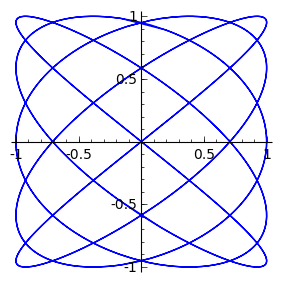Parameters
Because we work mostly with Cartesian coordinates and graphs in those coordinates, we frequently find it useful to express the tuple, $(x,y)$, in terms of a third variable. So instead of just writing the values of $x$ and $y$, we would like to give a formula for calculating $x$ and $y$ from some third variable. Often that third variable is $t$ for time or $\theta$ for angle. In mathematics, the parameter variable can be $t,u,\tau,\theta,\phi$ and a whole host of other variables. Just read carefully. The parameter is a scaler. That would cause the coordinate pair, $(x,y)$, to be two new functions, $(x(t),y(t))$ or $(x(\theta),y(\theta))$. Sometimes, these new functions are really simple. For example, $x(t)=t\quad y(t)=f(t)$. In such cases, we may have used parametric equations without ever bothering to formalize the use. There are plenty of other instances where parametric equations can occur naturally or can assist in computer graphing. In three dimensions, there will be two parameters, often called $u$ and $v$ or $\theta$ and $\phi$. Quite complicated polynomials become tractable whenever their parametric form is available.
Naturally occurring parametric equations may arise from equation derivation. A good example is the cycloid shown later in this chapter. Another example is the derivation of a circle. From the Unit Circle one can see that every point on the circle has a functional description in terms of $[x(\theta)=r\cdot cos(\theta),\,y(\theta)=r\cdot sin(\theta)]$. Thus, that functional description is a parametric equation for the circle. Indeed, one should probably ask how to derive the analytic equation or polynomial representation that we refer to as the Pythagorean Theorem {Aside: You did notice that the Pythagorean Theorem and the circle equation are identical?} $$x^{2}+y^{2}=r^{2};\quad a^{2}+b^{2}=c^{2}.$$ For most parametric equations, there is a logical domain for the parameter. In the case of the circle it is $0\leq\theta\leq2\pi$. Usually there is no consequence for calculating with a parameter value outside the given domain, and in the case of a circle it will just duplicate values in the range.
Of course, equation derivations might not arrive at a parametric form. See for example the derivation of a right opening parabola in section. In that instance we arrived at a parabola equation of $y^{2}=4xp$. If we try to graph the equation $\eqref{EQ 1}$, it will have to be done twice over the same $x$ domain to accommodate the two solutions. $$y(x)=\pm2\sqrt{xp} \tag{EQ 1} \label{EQ 1}$$ If we had a set of parametric equations, there would be a unique $(x(t),y(t))$ pair for every $t$ in some domain. This is the time at which we discover that one can parametrize an expression of $(x,y)$ in an infinite number of ways. How to best select new functions will depend on the application. In the case of a parabola, a primary purpose is to have unique points for all values of the parameter. Clearly, if we set $x=t$ it would be of no value since $y(t)=\pm2\sqrt{tp}$. So we have to think, what $t$ value could replace$x$ in equation $\eqref{EQ 1}$ and permit the removal of the radical? If we let $x=t^{2}p$, then the part under the radical would be $(t^{2}p)\cdot(p)=t^{2}p^{2}$ which would then simplify to $tp$. $$ \begin{array}{c}x(t)=t^{2}p\\y(t)=2tp\end{array} \tag{EQ 2} \label{EQ 2}$$ Now if we graph equation $\eqref{EQ 2}$ in domain $-5\leq t\leq5$ we will get the expected right opening parabola without having to graph two different $y(x)$ functions.
In some respects, it seems that this is overkill whenever we could just graph the positive and negative side of equation $\eqref{EQ 1}$. However, look at figure Lissajous. In that case, the parametric plot has many overlaps and would require that the analytic function, assuming we could find one, be broken into multiple parts to be graphed.

Earlier we stated that a parametric equation for a unit circle is $$\mathbf{r}(t)=\left(\begin{array}{c} \cos(t)\\\sin(t)\end{array}\right)\quad0\le t\le2\pi. \tag{EQ 3} \label{EQ 3}$$ While that is the most common parametric circle, there can be many more. For example, $$\mathbf{r}(t)=\left(\begin{array}{c} \frac{1-t^{2}}{1+t^{2}}\\ \frac{2t}{1+t^{2}} \end{array}\right)\quad-\infty\le t\le\infty$$ yields a perfect circle, except that there is a hole at $(-1,0)$. No matter how large or small $t$ becomes, it never yields exactly $(-1,0)$. However, some parametrizations are superior in some applications. The circle of the second equation above always results in rational coordinates on the unit circle for rational values of $t$. Try finding those with $\eqref{EQ 3}$. {Aside: A rational value is one that can be expressed with an integer numerator and integer denominator.}